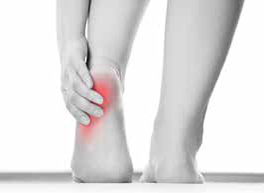
Inflammation and irritation of the plantar fascia ligament—plantar fasciitis—is the most common cause of pain on the bottom of the heel, with 2 million cases treated in the United States each year. This heavy band of tissue supports your arch and connects the front of your foot to your heel.
In 2014, a comprehensive review of studies by physical therapists and others about plantar fasciitis heel pain treatment modalities was published in the Journal of Orthopaedic & Sports Physical Therapy. The following treatments are currently found to be among the most effective
- Stretching. Regular stretching of the foot (the plantar fascia itself) can relieve plantar fasciitis pain. Calf stretching may be beneficial, although in a minority of patients it may cause additional pain in the heel, calf or elsewhere.
- Taping. Various kinds of athletic/medical tape (some coated with zinc oxide) can be used to wrap and support the plantar fascia. We can show you different taping methods and find the best option for relieving your particular pain.
- Orthotics. From leather to plastic, off-the-rack to custom-fitted, shoe inserts—or orthotics—that support the arch and cushion the heel can be helpful in reducing pain. If you respond well to taping, orthotics are likely to help, too.
- Night splints. While cumbersome, a night splint can be very effective to reduce pain and improve function. It positions your foot with your toes up while you sleep, providing a constant, mild stretch of the plantar fascia and the Achilles tendon.
We can conduct a physical examination to diagnose plantar fasciitis. However, if there’s any question, your physician can order tests to rule out other conditions. X-rays are commonly used to detect fractures, arthritis or heel bone spurs (although they often don’t cause pain). If those are ruled out, exercise and the techniques listed above will help alleviate discomfort.
If your heel hurts, you do not have to continue to suffer with pain. We can design a treatment program that will help you return to your daily work and recreational activities and maintain your optimal foot health without risk of further injury.
















